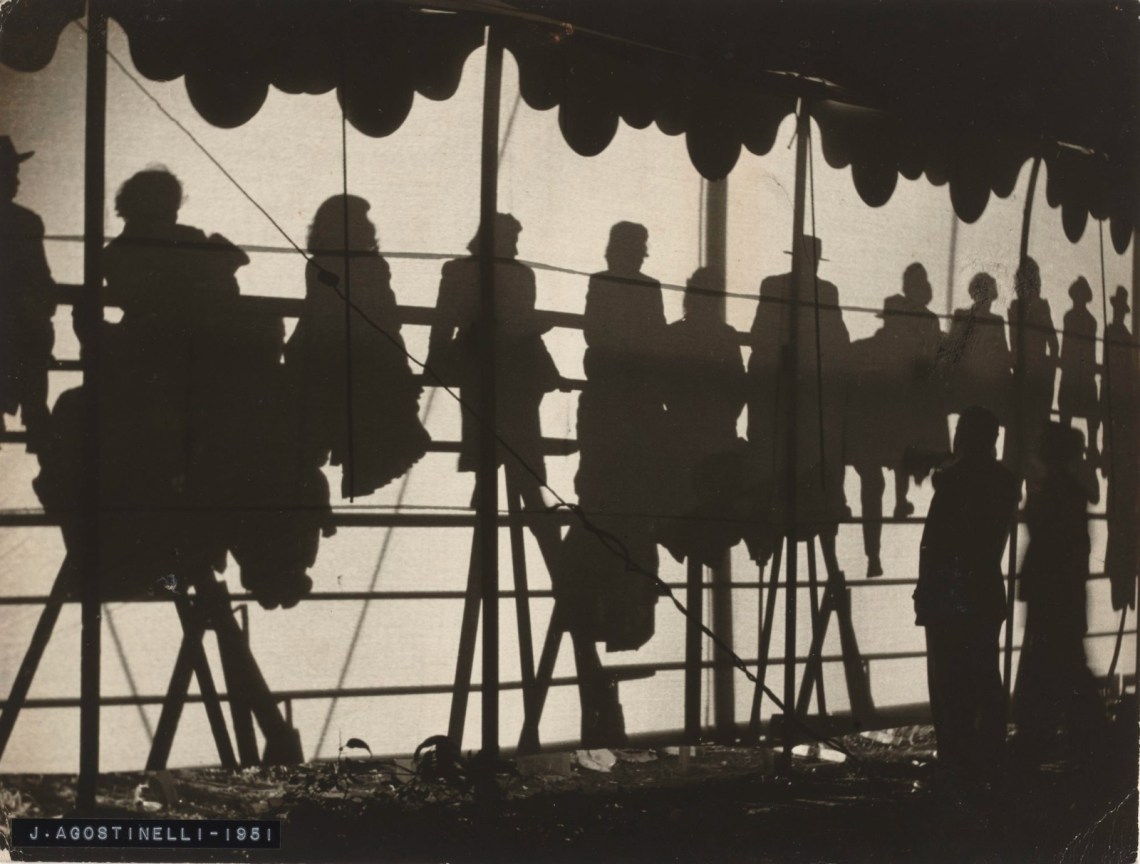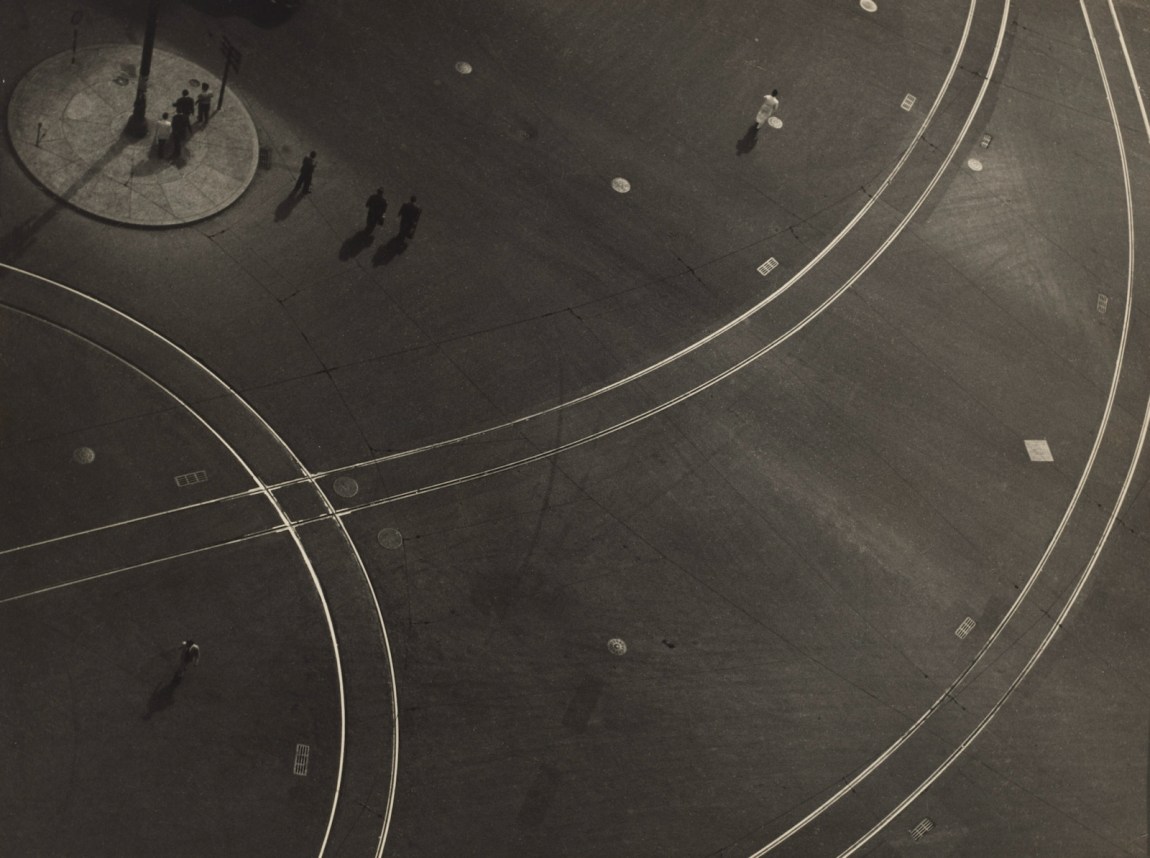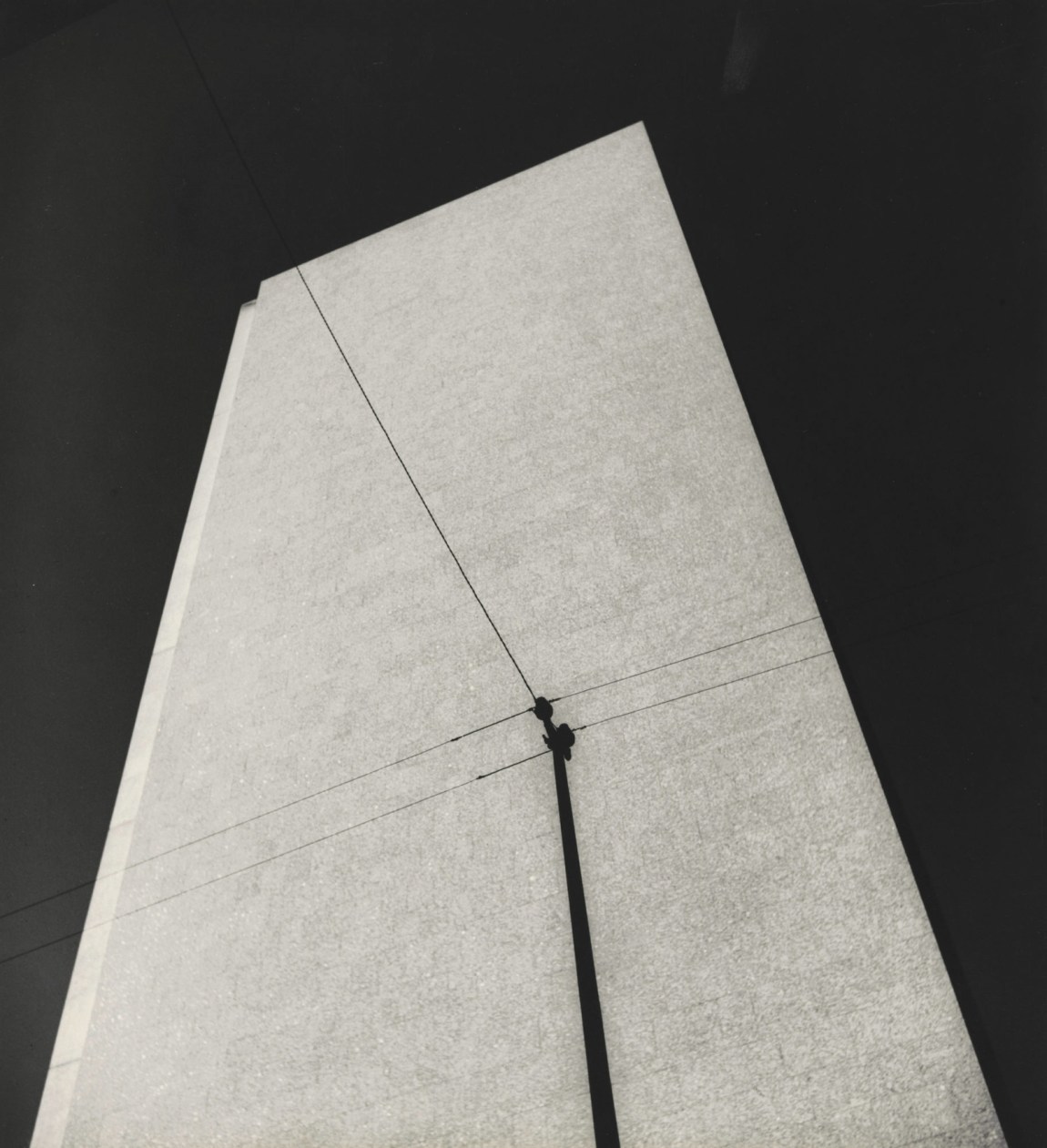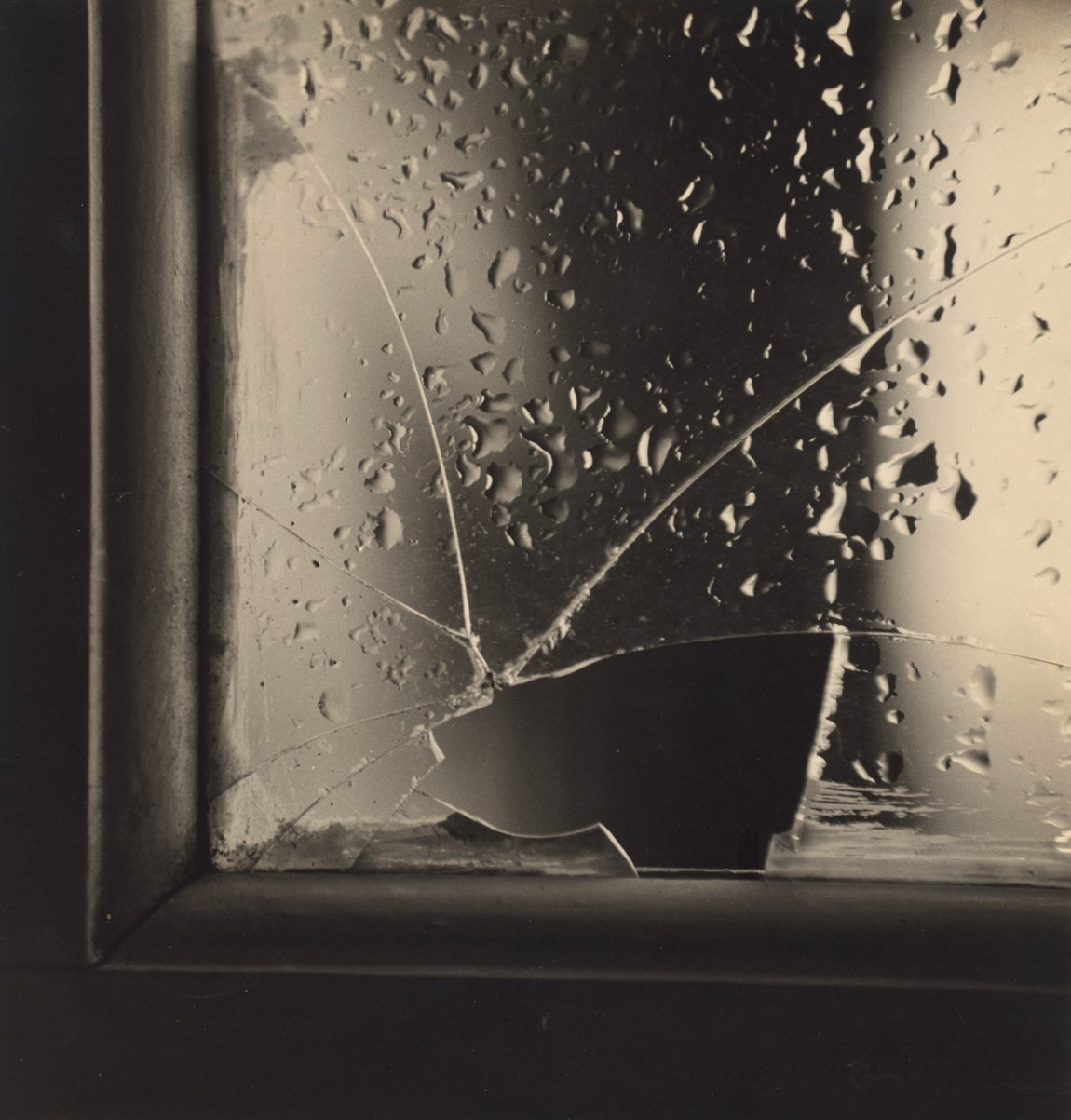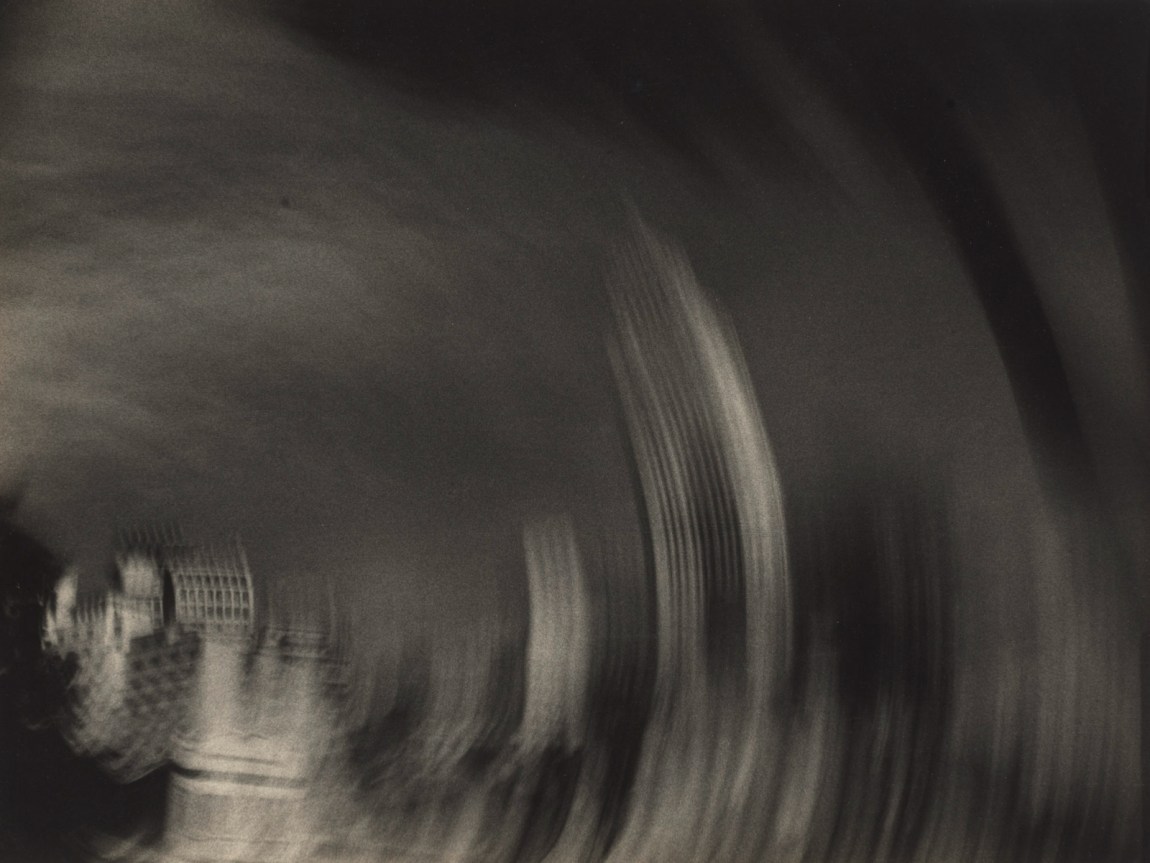“Fotoclubismo: Brazilian Modernist Photography, 1946–1964,” currently on view at the Museum of Modern Art, presents some sixty black-and-white photographs by members of the amateur Foto Cine Clube Bandeirante (FCCB) in São Paulo. Created in 1939, the club not only served as a social haven for upper-middle-class amateur photography buffs, but it also became a competitive creative laboratory. The exhibition covers the peak period of the club’s activity, from its first publication in 1946, the year Brazil ratified a new constitution restoring democracy, to the military coup in 1964, after which censorship and the curtailment of civilian freedoms under the dictatorship, in power until 1985, coincided with the waning of the FCCB’s influence.
The 1950s were a time of increased prosperity, partly stimulated by state-directed industrial development, which led to a mass migration of people from rural to urban areas. Modern movements in art (Concretism and Neo-Concretism) and architecture (Brutalism) were ascendant. The FCCB originally embraced Pictorialism, an international style that sought, with its painterly aesthetic, to elevate photography to the status of a fine art. By mid-century, however, such an approach seemed stale. Whereas the Pictorialists favored mythical themes and bucolic scenes, the fotoclubistas were increasingly drawn to urban architecture and quotidian street life. Not surprisingly, Brazil’s rapidly developing cities feature as the exhibition’s chief protagonists.
The show foregrounds three foundational figures: Geraldo de Barros, German Lorca, and Gertrudes Altschul. The first two were among the club’s early members or so-called pioneers (the club’s name, Bandeirante, meaning “flag-bearer” or “pioneer,” was taken from its original application as a term for white colonialist explorers). For her part, Altschul was associated with the São Paulo School (Escola Paulista), as the club’s Modernist vanguard eventually came to be called.
Their works mingle with those of other notable members, including Thomaz Farkas, Marcel Giró, and José Yalenti, grouped into the categories guided by subject and aesthetic: “Solitude,” “Daily Life,” “Experimental Processes,” “Texture and Shape,” and “Abstractions from Nature.” The themes draw on those of the club’s internal competitions, in which members received peer feedback and were judged on a point system (the points, which were also awarded for participating in international competitions or in the salons of other amateur clubs, were tallied regularly and published in editions of the club’s periodical, Boletim, along with the competitions’ winning images).
Modernist photography arrived late in Brazil but soon boomed. The First Salon of Photographic Art of São Paulo, organized by the FCCB in 1942, was followed by exhibitions at the recently established museums: for de Barros at the Museum of Modern Art São Paulo (MASP) in 1950, and for Lorca at the Museum of Modern Art (MAM-SP) in 1952. Popular with the public, the annual salons gained an international scope (in the years 1942–1959, more than one hundred foreign clubs and associations took part). Alongside other FCCB members, de Barros also organized an exhibition dedicated to the São Paulo School at the Second São Paulo Biennial in 1953. Furthermore, FCCB members frequently participated and won prizes in international competitions.
The separation between photography and the fine arts, though, was still distinct. Some of the fotoclubistas were eventually forgotten—so much so that the eminent photography historian Helouise Costa was surprised to find, in 1985, that Lorca’s output from the 1940s was virtually unknown. In fact, by the late 1950s, the allure of photographic abstraction had already waned, as its lessons were absorbed by publicity photography and photojournalism on one hand and by new trends favoring spontaneity and a more naturalistic approach, on the other.
Costa’s groundbreaking research led to Lorca’s rediscovery and sparked renewed interest in fotoclubismo generally, which in turn helped draw the attention of international institutions like MoMA. But this show also furthers MoMA’s own efforts—recently evinced in the museum’s “Degree Zero—Drawing at Midcentury” exhibit—to present the story of mid-century Modernism in a less Western-centered and more globally inclusive manner.
Organized by MoMA’s departing photography curator, Sarah Meister, “Fotoclubismo” scaled down its plans to show material on loan because of the pandemic, and instead draws primarily on the museum’s collection of Brazilian photographs. Whereas the magazines produced by the Foto Cine Clube—some issues are displayed at MoMA in two glass cases—suggest a widely diverse range of aesthetic approaches, the show highlights the club’s Modernist vanguard, with its penchant for rhythmic geometric forms, dramatic camera angles, and high contrasts. Formal interventions, such as montage, solarization, and multiple exposures, are also common.
This dominant aesthetic lent itself to bold compositions. Thomaz Farkas’s Ministry of Education (1945) makes the Capanema Palace in Rio de Janeiro look like a single sheath of concrete, stressing its grandeur while simultaneously collapsing volumetric mass to a flat plane. The building was the brainchild of a team that included the urban planner Lúcio Costa and the architect Oscar Niemeyer; the two later carried out the plan for Brazil’s new capital, Brasília.
Advertisement
An imposing sense of scale also appears in Eduardo Salvatore’s Untitled (circa 1951), in which identical apartment blocks in São Paulo’s Várzea do Carmo housing complex dwarf a lone human figure. In Marcel Giró’s Untitled (circa 1950), two men stand on a staircase—their figures looming large thanks to the camera’s acute slant and appearing like spectral Alberto Giacometti sculptures. Fotoclubistas often captured modern cityscapes’ minimalism and verticality (this trope is clear in the plunging street views found in Gaspar Gasparian’s Divergent (1949) and André Carneiro’s 1951 Rails). Ademar Manarini’s Untitled (circa 1951) again depicts Várzea do Carmo, but with a single man’s dark silhouette haunting the housing unit’s white walls, in a composition that ingeniously distorts the viewer’s perception of depth by conflating background and foreground.
Other works dramatize the energy and transience of modern life. Lorca’s Congonhas Airport, São Paulo (1961), with its inky, jagged contours seemingly liquified by heat and speed, records travelers in a bustling terminal. Meanwhile, in Barbara Mors’s Sunday (circa 1953), three men watch a soccer match on a dusty field, against a row of modest houses—a rare glimpse of leisure that depicts the working class.
Abstraction is synonymous with the work of Geraldo de Barros, one of the club’s most radical experimenters. Versed in diverse media, including engraving, design, painting, and collage, de Barros only briefly dedicated himself to photography (this initially led scholars to downplay his affiliation with FCCB). In his Abstraction (1949) and one of two works titled Fotoforma (circa 1949), montage and multiple exposures render urban elements such as telephone cables as intricate grids of overlapping planes and textures. For Fotoforma (1952–1953), de Barros punched holes in his punch card at Banco de Brasil (like most fotoclubistas, de Barros held a day job). The image’s staccato of small black rectangles brings to mind Piet Mondrian’s Broadway Boogie Woogie (1942–1943), just a few rooms away on the same floor, in MoMA’s David Geffen wing. But it’s also a result of a mechanical process: an impression of light, shone onto the photographic paper, through the perforations.
In their book, Modern Photography in Brazil (2004), Helouise Costa and fellow art historian Renato Rodrigues da Silva argue that while de Barros didn’t describe his work as “Constructivist,” his photography can be seen as a precursor to Concrete Art. The movement, which originated in Europe and was popularized in Latin America by the Swiss artist and architect Max Bill, opposed the naturalist, nationalist art then in vogue. After his “Fotoformas” exhibition at MASP baffled the more conservative FCCB members, de Barros dedicated himself primarily to painting. In 1952, he founded São Paulo’s Ruptura (“Rupture”)—a Concrete Art group, which championed geometric abstraction.
The fotoclubistas were also influenced by Surrealism, as manifested in the photographs by Lorca, who died this past May at the age of ninety-nine. His most famous photograph, Study with Chair (1951), not on view at MoMA, alluded to the Surrealist concept of the uncanny, imagined by the French poet Comte de Lautréamont as the chance meeting of a sewing machine and an umbrella.
In Lorca’s carefully staged Rascality (1949), two men standing in a doorway are shown from their knees down, so that only their polished shoes and suit pants are visible. The composition’s dark palette and languid shadows heighten its aura of mystery. Lorca’s Solarized Portrait (circa 1953) made by re-exposing photographic paper during the development process, resulting in a lush, smoky-looking palette—a technique that Lorca learned at the FCCB from de Barros—likewise exudes a noir atmosphere. Elsewhere, as in Everyday Scenes (1949), Lorca captures the intrigue of chance encounters with great observational acumen, which has led critics to compare him to such humanist French photographers as Henri Cartier-Bresson and André Kertész.
Some of the most remarkable images at MoMA belong to Gertrudes Altschul. In her Untitled (circa 1955), subtle gradations of gray add depth to the dense tapestry of delicate leaves pictured. In Filigree (Filigrama) (1953), Altschul captures a papaya leaf’s minute veins with such painstaking sharpness that it looks rendered by a master draftsman. Meanwhile, a lone shadow of the stalk swoops into the picture, in a thick curve, disturbing the image’s delicacy.
In Lines and Tones (1953), Altschul depicts architectural elements in a vertiginous upward sweep, split by a wavy line. To produce the image, Altschul combined multiple takes, setting a building and two chimneys at conflicting angles. The composition distorts perspective, creating a disorienting, undulating dreamscape, lucid yet slightly reeling. In this sense, Altschul presents control over natural laws as quintessential of modernity. While the image perfectly encapsulated the Brazilian Modernists’ utopian belief in unfettered progress, today its depopulated scenery also suggests a desolate wasteland, a by-product of widespread industrialization.
Advertisement
Unlike de Barros, or Lorca, who opened a commercial photography studio, Altschul, who ran a business with her husband making artificial flowers for milliners, remained strictly an amateur. Her mastery serves as a salient reminder that the traditional distinction between amateur and art photography often fails to account for a broader spectrum of those taking photos outside the traditional networks, which have come to include art fairs, galleries, and museums. Altschul’s peripheral status—as an amateur, a Brazilian, and a woman—hardly makes her work any less original.
Yet such a bias has been compounded by Western scholars, who have often cast works from the Global South as minor or derivative—a point that Meister emphasizes in the catalog, itself a valuable resource; her essay compares the FCCB to other international amateur clubs, and the catalog features far more noteworthy photographers and reproductions than fit on the walls at MoMA.
These amateur clubs’ reach and dynamism make them central to wider discussions on Modernism. Their network included: the more Pictorialist Photographic Society of America (PSA); the French Groupe des XV (Group of Fifteen), which was aligned with the FCCB’s interest in the everyday; and the German group Fotoform, which was akin to the São Paulo School in its inventiveness. In Latin America, too, there were other attempts to forge a distinctly Modernist aesthetic—Meister notes the Carpeta de los Diez (Group of Ten) in Buenos Aires and La Ventana (The Window) in Mexico City.
The cross-cultural exchanges weren’t without disparities. The FCCB organized shows of Western photographers in Brazil, yet Latin American artists weren’t necessarily included in European exhibitions. In the US, the FCCB’s pioneering member Thomaz Farkas visited MoMA in 1948. His meeting with Edward Steichen, the director of the department of photography, resulted in the museum’s acquisition of a Farkas print in 1959. Nevertheless, Steichen excluded Brazil from his major show “The Family of Man” in 1955, featuring mostly European and American photographers, and MoMA’s acquisitions of Latin American photography remained sporadic for decades after that. It was not until 2005 that the museum started making a concerted effort to acquire works by Brazilian photographers.
In On Photography, Susan Sontag wrote that “time eventually positions most photographs, even the most amateurish, at the level of art.” But as Meister’s essay pointedly describes, recognition also depends on a complex network of interest, access, and exchange. “Fotoclubismo” is a welcome, if belated, correction of those historic asymmetries.


